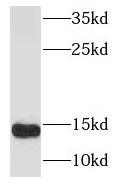产品
S100A9 antibody
| 别称: | Protein S100-A9|Calgranulin-B|Calprotectin L1H subunit|Leukocyte L1 complex heavy chain|Migration inhibitory factor-related protein 14 (MRP-14 antibody, p14)|S100 calcium-binding protein A9|S100A9|CAGB|CFAG|MRP14 antibody | ||
| 货号: | FNab07565 | 反应性: | Human |
| 宿主: | Rabbit | 验证实验: | ELISA, WB, IHC |
| 克隆性: | polyclonal | 亚型: | IgG |
| 规格 | 价格 |
|---|---|
| 100μg | RMB ¥2100 |
| 50μg | RMB ¥1260 |
| 20μg | RMB ¥630 |
- 产品介绍
- 实验结果
- 实验条件
- 常见问题
- 产品名称
- S100A9 antibody
- 货号
- FNab07565
- 规格
- 100μg
- 状态
- liquid
- 纯化方法
- Immunogen affinity purified
- 纯度
- ≥95% as determined by SDS-PAGE
- 克隆性
- polyclonal
- 亚型
- IgG
- 存储
- PBS with 0.02% sodium azide and 50% glycerol pH 7.3, -20℃ for 12 months(Avoid repeated freeze / thaw cycles.)
- 免疫原
- S100 calcium binding protein A9
- 别称
- Protein S100-A9|Calgranulin-B|Calprotectin L1H subunit|Leukocyte L1 complex heavy chain|Migration inhibitory factor-related protein 14 (MRP-14 antibody, p14)|S100 calcium-binding protein A9|S100A9|CAGB|CFAG|MRP14 antibody
- UniProt ID
- P06702
- 分子量
- 14 kDa
- 验证实验
- ELISA, WB, IHC
- 建议稀释比例
- WB: 1:500-1:2000; IHC: 1:20-1:200
 human heart tissue were subjected to SDS PAGE followed by western blot with FNab07565(S100A9 antibody) at dilution of 1:500
human heart tissue were subjected to SDS PAGE followed by western blot with FNab07565(S100A9 antibody) at dilution of 1:500
 Immunohistochemistry of paraffin-embedded human breast cancer tissue slide using FNab07565(S1009 Antibody) at dilution of 1:200
Immunohistochemistry of paraffin-embedded human breast cancer tissue slide using FNab07565(S1009 Antibody) at dilution of 1:200
- 背景介绍
- S100A9 is a calcium-and zinc-binding protein which plays a prominent role in the regulation of inflammatory processes and immune response. It can induce neutrophil chemotaxis, adhesion, can increase the bactericidal activity of neutrophils by promoting phagocytosis via activation of SYK, PI3K/AKT, and ERK1/2 and can induce degranulation of neutrophils by a MAPK-dependent mechanism. Predominantly found as calprotectin(S100A8/A9) which has a wide plethora of intra-and extracellular functions. The intracellular functions include: facilitating leukocyte arachidonic acid trafficking and metabolism, modulation of the tubulin-dependent cytoskeleton during migration of phagocytes and activation of the neutrophilic NADPH-oxidase. Activates NADPH-oxidase by facilitating the enzyme complex assembly at the cell membrane, transferring arachidonic acid, an essential cofactor, to the enzyme complex and S100A8 contributes to the enzyme assembly by directly binding to NCF2/P67PHOX. The extracellular functions involve proinfammatory, antimicrobial, oxidant-scavenging and apoptosis-inducing activities. Its proinflammatory activity includes recruitment of leukocytes, promotion of cytokine and chemokine production, and regulation of leukocyte adhesion and migration. Acts as an alarmin or a danger associated molecular pattern(DAMP) molecule and stimulates innate immune cells via binding to pattern recognition receptors such as Toll-like receptor 4(TLR4) and receptor for advanced glycation endproducts(AGER). Binding to TLR4 and AGER activates the MAP-kinase and NF-kappa-B signaling pathways resulting in the amplification of the proinflammatory cascade. Has antimicrobial activity towards bacteria and fungi and exerts its antimicrobial activity probably via chelation of Zn(2+) which is essential for microbial growth. Can induce cell death via autophagy and apoptosis and this occurs through the cross-talk of mitochondria and lysosomes via reactive oxygen species(ROS) and the process involves BNIP3. Can regulate neutrophil number and apoptosis by an anti-apoptotic effect; regulates cell survival via ITGAM/ITGB and TLR4 and a signaling mechanism involving MEK-ERK. Its role as an oxidant scavenger has a protective role in preventing exaggerated tissue damage by scavenging oxidants. Can act as a potent amplifier of inflammation in autoimmunity as well as in cancer development and tumor spread. Has transnitrosylase activity; in oxidatively-modified low-densitity lipoprotein(LDL(ox))-induced S-nitrosylation of GAPDH on 'Cys-247' proposed to transfer the NO moiety from NOS2/iNOS to GAPDH via its own S-nitrosylated Cys-3. The iNOS-S100A8/A9 transnitrosylase complex is proposed to also direct selective inflammatory stimulus-dependent S-nitrosylation of multiple targets such as ANXA5, EZR, MSN and VIM by recognizing a [IL]-x-C-x-x-[DE] motif.
抗体可以回收利用几次?
一般抗体不推荐回收利用,抗体使用之后缓冲体系已经发生改变,不同客户在回收抗体的保存条件上也会有差异,所以抗体回收使用效果无法保证。
FineTest公司也做过一批抗体回收验证测试,测试结果显示不同抗体可回收次数不同,一般效价越高的抗体,可重复使用的次数越多,客户可根据实验情况来确定。
注:我们将孵育完毕后剩余的抗体回收到离心管中置于4℃保存,效价高的抗体可至少保存1周,重复利用3次左右。
FineTest公司抗体buffer成分是什么?
FineTest抗体成分一般是PBS含proclin300或sodium azide、BSA、50%甘油;也有一些是PBS含proclin300或sodium azide,50%甘油。防腐剂proclin300或sodium azide是常用的防腐剂,广泛应用于实验室和工业中。
FineTest公司抗体的保存温度和时间?
大部分抗体是放在-20℃保存,直标流式抗体需要放在2-8℃保存,质保期一年,质保期内抗体出现售后,可进行退货或换货。
一般抗体超过一年质保期仍旧可以使用,我们可以提供技术支持服务。
FineTest公司抗体使用需要稀释吗?用什么溶液稀释?
除了直标流式抗体为即用型,不用稀释。其他抗体一般为浓缩型,使用时需要按照说明书建议稀释比例稀释。
不同实验使用的稀释液不同,用PBST, TBST, 抗体封闭液等常用抗体稀释液均可。
免疫组化实验抗体的修复方式?
常用修复液:Tris-EDTA缓冲液(Tris-EDTA Buffer, pH 9.0);柠檬酸盐缓冲液(Citrate Buffer, pH 6.0)
热修复:
方法1:沸水浴修复,将盛有修复液和玻片的烧杯置于沸水浴环境,保持外部沸腾状态15min,自然冷却至室温;
方法2:微波修复,将盛有修复液和玻片的烧杯置于微波炉中,高火5min,停火3min,中火5min,自然冷却至室温。
如何选择二抗?
(1)二抗是和一抗反应的,所以二抗必须是抗一抗宿主物种,比如一抗来源于兔,对应二抗则选择抗兔二抗,比如羊抗兔或驴抗兔。
(2)根据实验类型选择二抗偶联物,比如做ELISA, 蛋白质印迹,IHC实验,常用酶联二抗,如HRP,AP等标记。而免疫荧光实验,流式细胞术实验中,则用荧光蛋白或染料标记,比如FITC,Cy3等。














